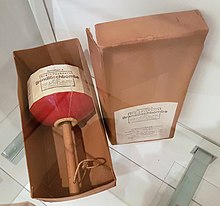bomb


A bomb is an explosive device which is filled with explosive material by an igniter (depending on the type. E.g. time, radio or impact fuse) to the detonation can be brought in order to cause destruction or kill people. Their massive use against a target is called bombing .
etymology
The word "bomb", like many other military terms, was probably borrowed from the French ( bomb ) during the Thirty Years' War and goes over Latin . bombus ultimately to the onomatopoeic ancient Greek word βομβος (Bombo) back, which means "dull tones, ringing".
Word application
In a military context, the word bomb is mostly used for explosive devices that are propelled by gravity in free fall without a propellant charge . This is particularly true in military aviation for the aerial bomb , but also for depth charges , which sink into the water without propulsion to fight submarines.
Explosive devices of a similar type are grenades (devices that experience initial acceleration from a propellant charge or manually) and mines ( weapons that are misplaced and, as a rule, detonate with a time delay under certain conditions).
In the civil context, the term "bomb" usually covers all types of explosive devices that serve criminal or terrorist purposes, e.g. B. Car bombs, letter bombs, booby traps, etc.
There are different types of bombs per se, which are designated according to their use or the explosive used.
- The time bomb by means of a time fuze for at a given time explosion accommodated.
- Car bomb - a bomb deposited in an automobile . The car bomb is used to murder the occupants or the car itself is used as a flexible carrier vehicle for destroying or murdering people, objects and / and buildings in the vicinity.
- Depth bomb - bomb to combat submarines
- The aerial bomb is a bomb dropped from an airplane, u. a. Incendiary bombs , aerial mines , roll / rotation bombs , high explosive bombs and aerosol bombs and are mostly ignited by means of an impact fuse. Equipped or retrofitted with a seeker head, it becomes a precision bomb .
- The nuclear weapon (atomic bomb) is a bomb whose explosion is based on a nuclear chain reaction . This also includes the hydrogen bomb , in which nuclear fusion takes place in addition to nuclear fission .
- The neutron bomb - a bomb that is similar to the atomic bomb , but emits considerably more energy in the form of hard neutron radiation, especially for fighting armored formations.
- The so-called radiological weapon (“dirty bomb”) is a “conventional” bomb that is mixed with radioactive material that contaminates an area when it explodes . Unlike the atomic bomb, however, there is no nuclear reaction.
- The letter bomb contains an explosive charge, which via a contact fuse, z. T. also via a timer , is triggered and used for terrorist attacks.
- The so-called e-bomb causes a massive electromagnetic pulse that can render electronic devices unusable.
- The smoke grenade (smoke bomb), which generates a lot of smoke in order to e.g. B. to take the view of the enemy or to simulate fire.
- The fire extinguisher bomb - a forerunner of modern handheld fire extinguishers - was a device that released water through an explosion and thus extinguished a fire .
- The water bomb as a toy is a particularly small balloon which , when connected to the tap, is filled with typically 0.5 liters of water, closed, thrown and bursts when it hits.
- The task of the (caloric) bomb in the calorimeter is to encapsulate the combustion of a material sample in a pressure- and volume-tight manner and to buffer it thermally.
- In Italian, after bomba (bomb), various gas bottles , mostly made of steel, bombola and spray cans are called bomboletta - two diminutive forms.
- The bomb or grenade with a burning fuse is the emblem of the Swiss Grenadiers and the Italian Carabinieri .


